by bria4123 on September 2, 2011
In the beginning, all was chaos. Then broad-breasted Earth emerged as a firm ground for all beings. Dark Tartaros opened in a chasm of Earth. Eros also came into being. He’s the fairest of the gods.
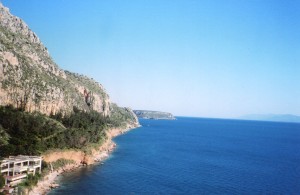
Clear boundaries between the Greek coast and the sea
This is how the ancient Greek poet Hesiod felt that creation happened. Boundaries between domains are primary. First Earth is sharply distinguished from Chaos as the ground we all can stand on. Tartaros is demarcated from Earth as the opposite of what we can live in–it’s dark and misty.
Hesiod’s beautifully Greek mind continued to work. Earth gave birth to Sky and Ocean. More demarcations.
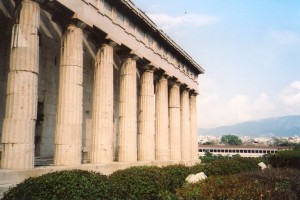
Athens' agora
Hesiod lived just after 700BCE. He and Homer were the two most influential ancient Greek poets, and their ideas still reverberate throughout the West. G.S. Kirk and J.E. Raven, in The Presocratic Philosophers, said that Hesiod influenced Greek ideas of the universe more than any other poet did.
When Hesiod lived, Greeks began to build stone temples with clear outlines. They’re perfect distinct entities, and models of order and eternity.
Greeks also began to fashion the proportioned distinct object in sculpture and ceramics. Their focus on this idea was thus reinforced through many media.
What a contrast with Indian cosmology. [click to continue…]
by bria4123 on September 2, 2011
People joke that Chennai has three seasons: hot, hotter and hottest.
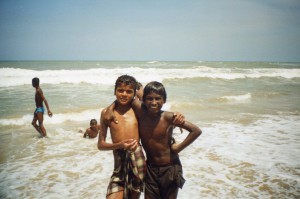
A real Indian summer
But in early December, the monsoon roared in. Sheets of rain slammed the dorm walls and wind ripped panels off the main hall. The water quickly rose to the middle of my thighs.
It felt so good to wade in its cool caresses until a groundskeeper warned me about poisonous snakes. Everyone finally had to evacuate to an apartment building on higher ground. [click to continue…]
by bria4123 on September 2, 2011
Things seem to happen on a cosmic scale in India. While living just outside Chennai in 1996, I routinely got up around 6 AM, and walked outside the dormitory towards the showers. It was late summer, and temperatures rocketed during the day.
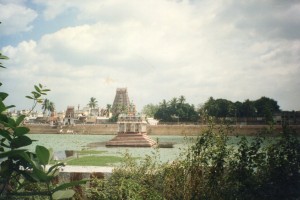
At 6 AM the weather was already warm. The air was still and the neighborhood was quiet. The area was rustic. Most homes had thatched roofs and dirt floors. This time is considered ideal for meditating–night becomes day and both are equally balanced. Things are still, like the original unity that the universe emanated from.
But it was already hotter when I finished my shower. Sweat began to drip from my temples and the back of my neck as I strolled back to the dorm. High-pitched nasal voices of female singers now emanated from radios of the local farmers. Pariah dogs barked and cows mooed. [click to continue…]
by bria4123 on September 2, 2011
In Angkor Wat, Part One, we dared to approach the divine world that Angkor’s king created. We’ll proceed, if we can survive the heat, busloads of tourists, and mysterious powers.
1. Angkor Wat was made for regal processions. The anticipation builds as you walk on the causeway towards the center. The hot sun makes it seem that the energies that the universe came from are concentrated there.
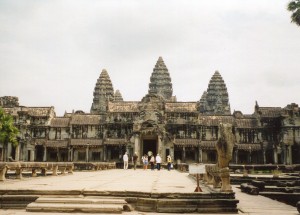
2. Eleanor Mannikka, in Angkor Wat, Time, Space, and Kingship, claimed that Angkor Wat is full of measurements that were associated with Indian ideas of gods and astronomy. She found the numbers 28, 32, 45 and 108 thoughout the temple. Angkor Wat might have been a map of the universe according to Hindu mythology. [click to continue…]
by bria4123 on September 1, 2011
India assumes many forms. I’ve heard lots of people’s interpretations of this land that are contrary to each other. It takes a lot of breadth and nuance to do her culture justice.
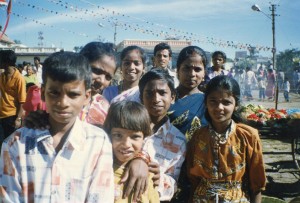
- German scholars in the late nineteenth and early twentieth century saw her as a model of spirituality. So did Indian Vedantists like Swami Vivekananda.
- Others have seen her as sensual–the land of the Kama Sutra. Octavio Paz latched onto this idea during his six-year tenure as the Mexican ambassador. He described a genre of erotic Sanskrit poetry that I wasn’t aware of. Its super-refined details made me horny.
- Today, many Indians love business, cricket and Bollywood. The country’s average age is 25, and young people are eager to ditch the past’s baggage. They want their country to be a tiger rather than an elephant.
- The Nobel Prize-winning economist Amartya Sen, in The Argumentative Indian, wrote that the current love of business isn’t new. Indians have always loved commerce. Many rich ancient dynasties reveled in finery. The Tamil epic the Cilappatikaram described a society of merchants with tall houses, frolicking on the beach with flowers in their hair. California dreaming–a heck of a lot hotter though.
So what’s the real India? [click to continue…]
by bria4123 on September 1, 2011
I recently read that Africa has seven of the world’s ten fastest growing economies. But it’s also one of the planet’s most culturally rich areas.

I met a Nigerian man in a German train station. I was eating dinner in its food court, and my table was next to the open area between the counters. He approached from my front. As he walked by, he picked up my coke bottle as though he was stealing it, but put it back down and walked by with a sly smile. I hoped he would come back.
I had read the Yoruba people in Nigeria see play as a key aspect of life. It infuses some of their rituals. Folks parody each other, crack jokes and exchange roles. Some stereotype white people as unable to play. We’re too serious and hung up about our roles. I didn’t want this man to see me in this way just because I have a balding head and glasses.
I kept an eye out for him, and a few minutes later, saw him returning from behind. Yes! [click to continue…]
by bria4123 on August 31, 2011
The Khmers knew how to impress. Here are some of the most interesting facts and ideas about Angkor Wat I found during a recent trip there:
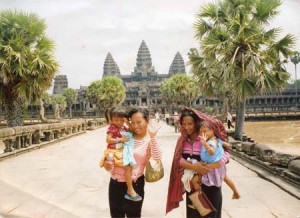
A friendly Khmer welcome
1. Angkor Wat was built in the early twelfth century–exactly when the French pioneered Gothic architecture in the Basilica of St. Denis. Europeans constructed towering naves and choirs surrounded by stained glass that filled them with light. Khmers couldn’t fashion arches to span large volumes, so the stone rooms they built were narrow and dark. But they made up for it by going horizontal–Angkor Wat’s total area is almost a square mile. It’s filled with sculpture and forms that mix Indian and native symbolism. Gothic style and Angkor Wat represent two great cultures’ ways of seeing the world.
2. Angkor Wat is the largest temple in Southeast Asia.
3. Angkor Wat is a microcosm of the Hindu universe. The central tower embodies Mt. Meru, which was the home of the gods at the center of the world.
4. The temple’s builder, King Suryavarman II, dedicated it to Vishnu. Most Kings had worshiped Shiva, so Angkor Wat’s builder was bucking tradition.
5. Most Khmer monuments face East, but Angkor Wat looks West–the direction often associated with Vishnu.
6. Vishnu was the sustainer of the universe, and Suryavarman might have cultivated a mystique about their souls merging. Angkor Wat was probably a trophy home with the king and Vishnu as joint owners–or the sole owner under two names? I don’t’ know how a modern real estate firm would classify this scheme, but Khmer kings could do what they wanted–they didn’t have to answer to a parliament or an independent church. [click to continue…]








